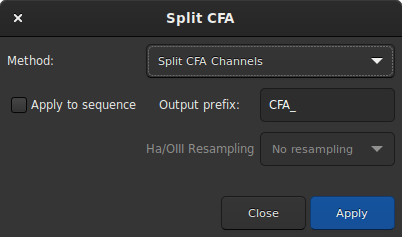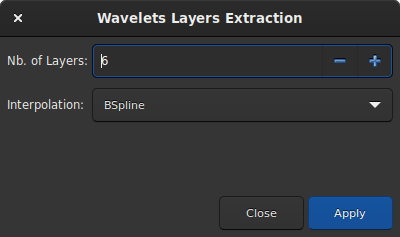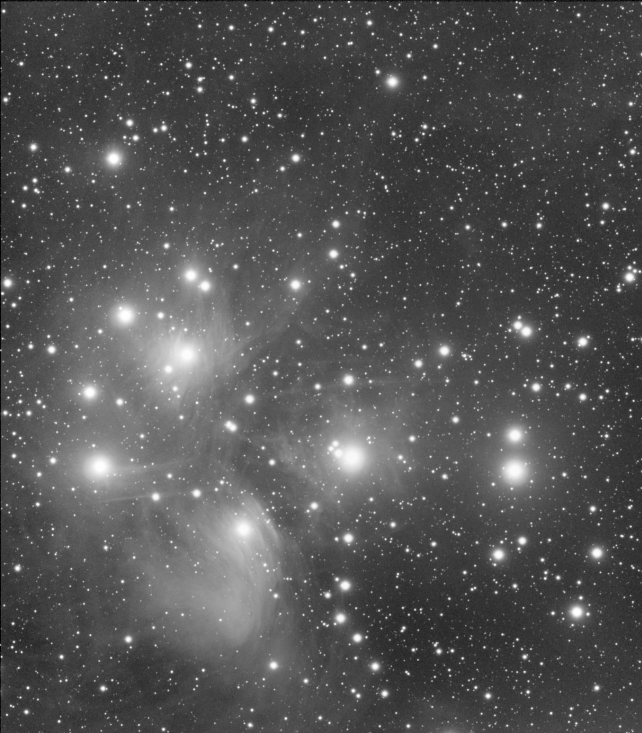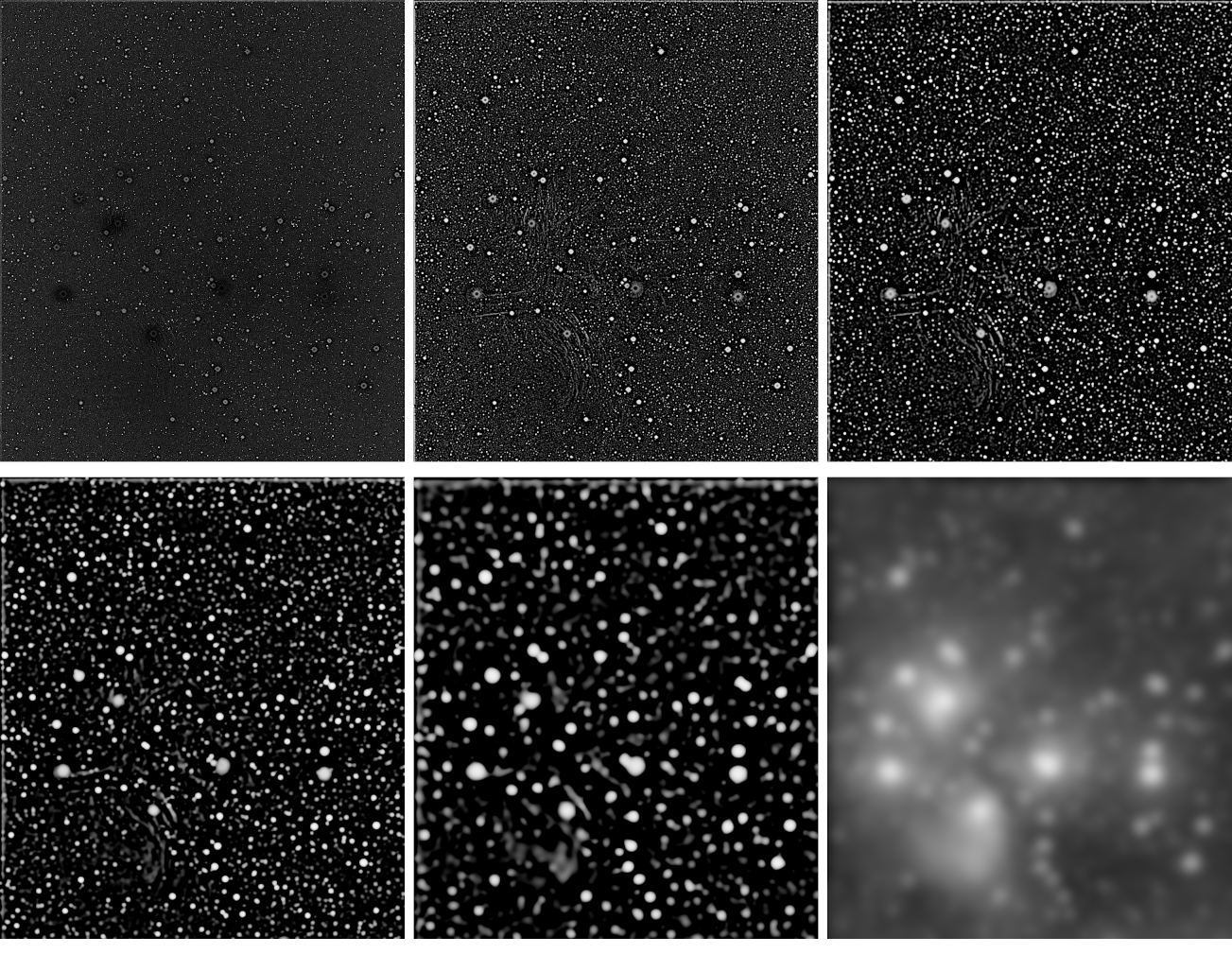Extraction
Split Channels
This function creates three monochrome images from a 3-channel color image, depending on the configured color space. For RGB, it’s simply splitting the file in three. For the others, it involves computation of the equivalent color space, either HSL (hue-saturation-lightness), HSV (hue-saturation-value) see , or CIELAB.

Split channels dialog box.
Tip
If no name is given to a channel, then the channel is not extracted.
Siril command line
split file1 file2 file3 [-hsl | -hsv | -lab]
Split CFA Channels
CFA means color filter array. This term is often used to describe one-channel image content of a color image, with each pixel corresponding to values acquired behind an on-sensor filter. This is to oppose to debayer images (or debayered or demosaiced).
Opening a CFA image in Siril is required for pre-processing, like removing the dark signal before interpolating the image into 3-channel color. We can also use the color filter information to extract images like this:
Split CFA Channels: four images are created from the CFA image, each representing one filter of the Bayer matrix, so in general R.fit, G1.fit, G2.fit and B.fit. It is useful if the goal is to process separately the different colors of the image.
Extract Ha: using an H-alpha filter with a color camera image (OSC: on-sensor color, or one-shot color camera) means that only the pixels with red filters will be useful, so in general only a quarter of them. This function creates a new image that contains only the pixels associated with the red filter documented in the Bayer matrix of the image.
Extract Ha/OIII: for OSC cameras, filters that let through photons from H-alpha and O-III wavelength have appeared. This extraction creates two images: an image from the red pixels like the Extract Ha, and an image combining the green and blue pixels into one for O-III. Both images are half the definition of the input image.
Note
There is a frequently asked question about why Ha and OIII images are different sizes and how they are split out. This note attempts to explain an answer to that FAQ.
In a colour image sensor the pixels are covered in a very fine filter matrix called a Color Filter Array (CFA) or Bayer matrix. The arrangement of filtered pixels is one of a number of patterns: RGGB, GBGR etc.

Original image by Cburnett, licensed as CC BY-SA 3.0.
Of these pixels, only the R pixels are sensitive to Ha. So first we split out all the red pixels into a Ha image. As only 1 in 4 of the CFA elements are red, the image dimensions of the Ha image are half that of the original sub.
The remaining pixels, G and B, are all sensitive to OIII. The sensitivity of the G filtered pixels to OIII is different to the sensitivity of B filtered pixels to OIII, however they are imaging the same scene and evenly distributed so the average intensity must be the same.
\[ \begin{align}\begin{aligned}\text{G}_\text{i} = \text{G}_\text{io} \times \frac{3 \times \overline{\text{G}_\text{o}}}{2 \times \overline{\text{G}_\text{o}} + \overline{\text{B}_\text{o}}}\\\text{B}_\text{i} = \text{B}_\text{io} \times \frac{3 \times \overline{\text{B}_\text{o}}}{2 \times \overline{\text{G}_\text{o}} + \overline{\text{B}_\text{o}}}\end{aligned}\end{align} \]Where \(\text{B}_\text{i}\) is the \(i^{\text{th}}\) blue pixel, \(\text{B}_\text{io}\) is the \(i^{\text{th}}\) original blue pixel and \(\overline{\text{B}_\text{o}}\) is the average of all the original blue pixels (and similarly for the green pixels).
So far we have an equalised set of G and B pixels with gaps where the R pixels have been removed. So finally we use bilinear interpolation to estimate the R pixel values and end up with a full size OIII image.
Note
The Ha/OIII resampling option is how to handle the output of Extract Ha/OIII. No resampling produces full resolution OIII image and a half resolution Ha image; upsample Ha upsamples the Ha image by a factor of 2 to match the OIII image; downsample OIII downsamples the OIII image by a factor of 2 to match the Ha image.
You may wish to use drizzling to upscale the Ha data instead of upscaling. As drizzling is a stacking method, in this case you must use seqextract_HaOiii to extract the Ha and OIII from each frame of the sequence, and then stack the OIII images in the usual way and the Ha images with a 2x drizzle.
Extract Green: for photometry, it’s often useful to only process the green part of the CFA image, because it is more sensitive and has two pixels to average, reducing noise even more. Of course, the created image also sees its definition halved by two.

Split CFA channels dialog box.
Note
These functions only work if the Bayer matrix has been properly documented by the acquisition software and if the image format supports it, so in general FITS or SER.
Warning
This does not work with other filter matrices than the Bayer matrices, like the Fujifilm X-TRANS.
Wavelet Layers
This tool extracts the different planes of the image by applying the wavelet process. Each plane is saved in an image and the set of images can be read as a sequence. You can choose up to 9 layers for the wavelet calculation and the type of the algorithm is either Linear or BSpline. The latter is usually the preferred one.

Wavelet Layers extraction dialog box.
The decomposition is done through a number of detail layers defined at increasing characteristic scales and a final residual layer, which contains the remaining unresolved structures.

Original image of M45 (courtesy of V. Cohas).

6 extracted planes.